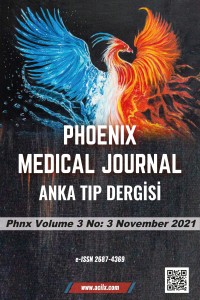Öz
Objective: Identification of the patients applying to the emergency medicine clinic with carbon monoxide (CO) poisoning and determination of treatment modalities.
Material and Method: The adult patients, that applied to Emergency Clinic with different reasons and diagnosed as CO poisoning, on February 2014 are included in this study. Patients are analized according to their age, complaints at the time of application, the type and time of their application, the source of their poisoning, lab test results and treatment types.
Results: Our study included 32 CO intoxicated patients. The mean age of the patients was 37.5 ± 17.8 years. 50 % of them were male. 93.75% (n: 30) of the patients applied to the emergency service between 08:00 pm and 08:00 am. The most frequent application type was with ambulance and 62.5% of patients` most common reason of poisoning was the heater (n: 20). The most common complaints were nausea, dizziness and headache. Mean COHb (Carboxyhemoglobin) values at the time of admission were 23.7 ± 9.2 (10-48.2). Two patients did not complete the study and all the remaining patients were discharged with healthy
Conclusion: CO poisoning is one of the most important reasons of application to the emergency clinics, especially in winter.It is an emergency situation that should be diagnosed at an earlier stage and given the lifesaving treatment immediately.
Anahtar Kelimeler
carbon monoxide intoxication emergency department carboxyhemoglobin
Kaynakça
- Anderson AR. Centers for Disease Control and Prevention (CDC). Top five chemicals resulting in injuries from acute chemical incidents—Hazardous Substances Emergency Events Surveillance, nine states, 1999-2008. MMWR Suppl. 2015;64:39-46.
- Jain KK. Carbon monoxide and other tissue poisons. Jain KK(eds). Textbook of Hyperbaric Medicine. 4th ed. Göttingen: Hogrefe&Huber; 2004. pp. 111-33.
- Harper A, Croft-Baker J. Carbon monoxide poisoning: undetected by both patients and their doctors. Age and Ageing. 2004;33:105-109.
- Kao LW, Nañagas KA. Carbon monoxide poisoning. Emerg Med Clin North Am. 2004;22:985-1018.
- Roth D, Herkner H, Schreiber W, Hubmann N, Gamper G, Laggner AN et al. Accuracy of noninvasive multiwave pulse oximetry compared with carboxyhemoglobin from blood gas analysis in unselected emergency department patients. Ann Emerg Med. 2011;58:74-79.
- Buckley NA, Juurlink DN, Isbister G, Bennett MH, Lavonas EJ. Hyperbaric oxygen for carbon monoxide poisoning. Cochrane Database of Syst Rev. 2011;13;(4) CD002041.
- Kandis H, Katırcı Y, Çakır Z, Aslan Ş, Uzkeser M, Bilir Ö. Acil servise karbonmonoksit entoksikasyonu ile başvuran olguların geriye dönük analizi. Akademik Acil Tıp Dergisi. 2007;5:21–25.
- Akköse S, Türkmen N, Bulut M, Akgöz S, Işcimen R, Eren B. An analysis of carbon monoxide poisoning cases in Bursa, Turkey. East Mediterr Health J. 2010;16:101-106.
- Deniz T, Kandiş H, Saygun M, Büyükkoçak Ü, Ülger H, Karakuş A. Kırıkkale üniversitesi tıp fakültesi acil servisine başvuran zehirlenme olgularının analizi. Düzce Tıp Fakültesi Dergisi. 2009;11:15–20.
- Akçal H, Tuygun N, Polat E, Karacan CD. Acute Carbon monoxide poisoning: experience of eight years. Eurasian J Emerg Med. 2015;14:189-191.
- American college of emergency physicians clinical policies subcommittee (writing committee) on carbon monoxide poisoning: Wolf SJ, Maloney GE, Shih RD, Shy BD, Brown MD. Clinical Policy: Critical Issues in the Evaluation and Management of Adult Patients Presenting to the Emergency Department With Acute Carbon Monoxide Poisoning. Ann Emerg Med. 2017;69:98-107.
- Sebbane M, Claret PG, Mercier G, Lefebvre S, Thery R, Dumont R, et al. Emergency department management of suspected carbon monoxide poisoning: role of pulse CO-oximetry. Respir Care. 2013;58:1614-1620.
- Yelken B, Tanrıverdi B, Çetinbaş F, Memiş D, Süt N. The assessment of QT intervals in acute carbonmonoxide poisoning. Anadolu Kardiyol Derg. 2009;9:397-400.
- Henry CR, Satran D, Lindgren B, Adkinson, Nicholson Cl, Henry TD. Myocardial injury and long-term mortality following moderate to severe carbon monoxide poisoning. JAMA. 2006;295:398- 402.
- Cha YS, Kim H, Hwang SO, Kim JY, Kim YK, Choi EH, et al. Incidence and patterns of cardiomyopathy in carbon monoxide-poisoned patients with myocardial injury. Clin Toxicol (Phila). 2016;54:481-487.
Öz
Amaç: Acil tıp kliniğine karbonmonoksit (CO) zehirlenmesi ile gelen hastaların tanımlanması ve tedavi şekillerinin belirlenmesidir.
Gereç ve Yöntem: Acil Tıp Kliniği’ne 2014 yılı Şubat ayı içinde çeşitli sebeplerle başvurup CO zehirlenmesi tanısı alan erişkin hastalar çalışmaya dahil edilmiştir. Hastalar yaş, cinsiyet, acil servise başvuru şekli ve saati, zehirlenme kaynağı, başvuru şikayetleri, laboratuar test sonuçları ve tedavi şekillerine göre incelenmiştir.
Bulgular: Çalışmamıza 32 CO zehirlenmesi olan hasta dahil edilmiştir. Hastaların ortalama yaşı 37,5 ± 17,8 yıl idi. Hastaların %50 (n:16) sı erkek idi. Hastaların %93,75 (n:30)’i akşam 08:00 ile sabah 08:00 saatleri arasında acil servise başvurmuştu. En sık başvuru şekli ambulans ile olup %62,5 (n:20) en sık zehirlenme kaynağı kombi olarak tespit edilmiştir. En sık başvuru şikayetleri bulantı, baş dönmesi ve baş ağrısı bulundu. Hastaların başvuru anındaki COHb (Karboksihemoglobin) değerleri ortalama 23,7 ± 9.2 (10-48,2) idi. Çalışmayı 2 hasta tamamlamadı ve geri kalan hastaların hepsi sağlıklı bir şekilde taburcu edildi.
Sonuç: CO zehirlenmesi, kış aylarında önemli bir acil servis başvurusu nedeni olup erken dönemde tanı konulup hızlıca hayat kurtarıcı tedavisinin yapılması gereken acil bir durumdur.
Anahtar Kelimeler
Kaynakça
- Anderson AR. Centers for Disease Control and Prevention (CDC). Top five chemicals resulting in injuries from acute chemical incidents—Hazardous Substances Emergency Events Surveillance, nine states, 1999-2008. MMWR Suppl. 2015;64:39-46.
- Jain KK. Carbon monoxide and other tissue poisons. Jain KK(eds). Textbook of Hyperbaric Medicine. 4th ed. Göttingen: Hogrefe&Huber; 2004. pp. 111-33.
- Harper A, Croft-Baker J. Carbon monoxide poisoning: undetected by both patients and their doctors. Age and Ageing. 2004;33:105-109.
- Kao LW, Nañagas KA. Carbon monoxide poisoning. Emerg Med Clin North Am. 2004;22:985-1018.
- Roth D, Herkner H, Schreiber W, Hubmann N, Gamper G, Laggner AN et al. Accuracy of noninvasive multiwave pulse oximetry compared with carboxyhemoglobin from blood gas analysis in unselected emergency department patients. Ann Emerg Med. 2011;58:74-79.
- Buckley NA, Juurlink DN, Isbister G, Bennett MH, Lavonas EJ. Hyperbaric oxygen for carbon monoxide poisoning. Cochrane Database of Syst Rev. 2011;13;(4) CD002041.
- Kandis H, Katırcı Y, Çakır Z, Aslan Ş, Uzkeser M, Bilir Ö. Acil servise karbonmonoksit entoksikasyonu ile başvuran olguların geriye dönük analizi. Akademik Acil Tıp Dergisi. 2007;5:21–25.
- Akköse S, Türkmen N, Bulut M, Akgöz S, Işcimen R, Eren B. An analysis of carbon monoxide poisoning cases in Bursa, Turkey. East Mediterr Health J. 2010;16:101-106.
- Deniz T, Kandiş H, Saygun M, Büyükkoçak Ü, Ülger H, Karakuş A. Kırıkkale üniversitesi tıp fakültesi acil servisine başvuran zehirlenme olgularının analizi. Düzce Tıp Fakültesi Dergisi. 2009;11:15–20.
- Akçal H, Tuygun N, Polat E, Karacan CD. Acute Carbon monoxide poisoning: experience of eight years. Eurasian J Emerg Med. 2015;14:189-191.
- American college of emergency physicians clinical policies subcommittee (writing committee) on carbon monoxide poisoning: Wolf SJ, Maloney GE, Shih RD, Shy BD, Brown MD. Clinical Policy: Critical Issues in the Evaluation and Management of Adult Patients Presenting to the Emergency Department With Acute Carbon Monoxide Poisoning. Ann Emerg Med. 2017;69:98-107.
- Sebbane M, Claret PG, Mercier G, Lefebvre S, Thery R, Dumont R, et al. Emergency department management of suspected carbon monoxide poisoning: role of pulse CO-oximetry. Respir Care. 2013;58:1614-1620.
- Yelken B, Tanrıverdi B, Çetinbaş F, Memiş D, Süt N. The assessment of QT intervals in acute carbonmonoxide poisoning. Anadolu Kardiyol Derg. 2009;9:397-400.
- Henry CR, Satran D, Lindgren B, Adkinson, Nicholson Cl, Henry TD. Myocardial injury and long-term mortality following moderate to severe carbon monoxide poisoning. JAMA. 2006;295:398- 402.
- Cha YS, Kim H, Hwang SO, Kim JY, Kim YK, Choi EH, et al. Incidence and patterns of cardiomyopathy in carbon monoxide-poisoned patients with myocardial injury. Clin Toxicol (Phila). 2016;54:481-487.
Ayrıntılar
| Birincil Dil | Türkçe |
|---|---|
| Konular | Acil Tıp |
| Bölüm | Araştırma Makaleleri |
| Yazarlar | |
| Yayımlanma Tarihi | 1 Kasım 2021 |
| Gönderilme Tarihi | 7 Mayıs 2021 |
| Kabul Tarihi | 29 Eylül 2021 |
| Yayımlandığı Sayı | Yıl 2021 Cilt: 3 Sayı: 3 |
Cited By
Karbon Monoksit Zehirlenmesi ve Kardiyak Fonksiyonun Sekelleri
Phoenix Medical Journal
https://doi.org/10.38175/phnx.1031828

Anka Tıp Dergisi Creative Commons Atıf 4.0 Uluslararası Lisansı ile lisanslanmıştır.
Anka Tıp Dergisi Budapeşte Açık Erişim Deklarasyonu’nu imzalamıştır.



